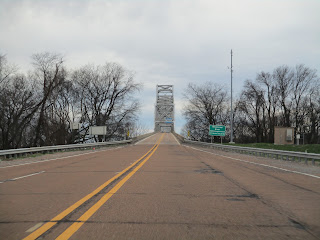Located along a relatively isolated segment of US Highway 49,
the Helena Bridge spans the Mississippi River in the northern reaches of the
Mississippi Delta region. Located about 25 miles north of the Delta crossroads
city of Clarksdale, this bridge is among the lightest-trafficked bridges on the
lower Mississippi River and is one that can easily be missed and forgotten
about.
Opened in 1961, the bridge was built to replace an
antiquated ferry service in the area and has been part of the US 49 corridor
since 1963, when that highway was extended north into Arkansas from Clarksdale along US 61 and a former segment of Mississippi Highway 6. The cost of construction was $14 million and it
operated as a toll bridge in its early years until the bonds issued for the
project were paid off some time later. The bridge is about one mile long altogether and features a narrow two-lane roadway that lacks modern shoulders.
In order to ensure that the approach highways would not be subjected to river
flooding, they were built on elevated earthen embankments that span the width
of the flood plain. The bridge’s main span consists of a multi-span steel
cantilever truss superstructure totaling over half a mile in length. The
longest of these spans is 804 ft long, clearing the Mississippi River below
with a height of 120 ft. It’s been said that the design of this bridge was
inspired by that of the old Benjamin Humphreys Bridge, another steel cantilever
bridge of similar appearance, once located downriver near Greenville, MS – a bridge
that will be featured as part of a future blog on this site.
On the Mississippi side of the bridge is the Isle of Capri Hotel & Casino Resort and it’s one of the only notable landmarks in the area nowadays. This area generally does not have much to offer, with the bridge being the biggest highlight for bridge enthusiasts alike. The consolidated city of Helena-West Helena on the Arkansas side of the bridge is the county seat and largest city within Phillips County, AR. While the Mississippi Delta has fallen on hard economic times over the last 50 years due to the loss of its manufacturing jobs, this area has a non-negligible amount of history to offer visitors. It was the site of the Civil War’s Battle of Helena in July 1863 and was also home to a thriving blues music community in the 1940s & 50s that rivaled that of Clarksdale, MS nearby, attracting much of the same talent as its counterpart just down US 49. Be sure to check out our blog's article on Clarksdale, a link to it will be provided below.
The following pictures from my February 2023 visit to the Helena Bridge demonstrate the westbound crossing from Mississippi to Arkansas. Click on each photo to see a larger version.
The following pictures from my February 2023 visit to the Helena Bridge demonstrate the eastbound crossing from Arkansas to Mississippi. Click on each photo to see a larger version.
Bridges, Crossings, and Structures of the Lower Mississippi River
Next Crossing upriver: Memphis & Arkansas Bridge (Memphis, TN)
Next Crossing downriver: Greenville Bridge (Greenville, MS)
Return to the Bridges of the Lower Mississippi River Home Page
__________________________________________________








































Comments